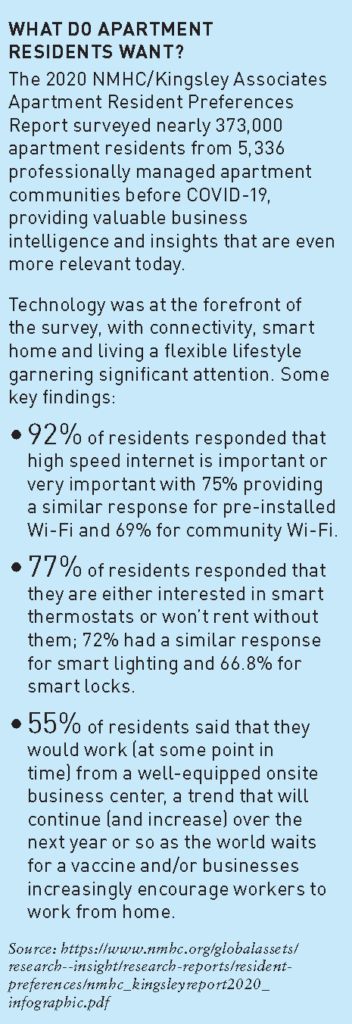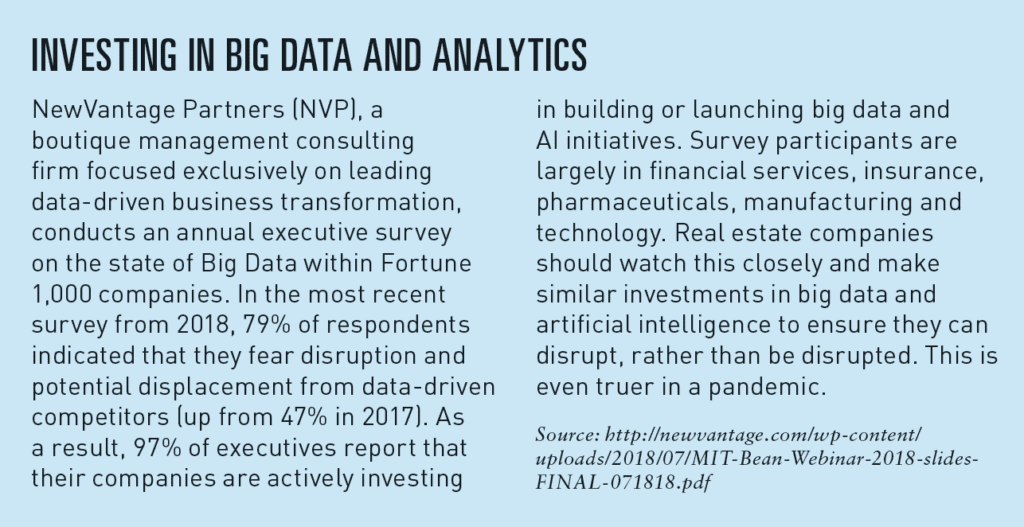This article appears in Summit Journal (Fall 2020) | Download PDF | Listen to the Podcast
Advancing automation, tech-driven amenities, and community building is key to winning—and keeping today’s tech-savvy residents.
In a crowded residential marketplace of products, opportunities, and managers, how does an investor select the right investment? Furthermore, how can investors outperform their broader peer group, especially amid a worldwide pandemic?
There are more than 43 million renter households in the US today, and this number is projected to grow to nearly 53 million by 2030.[1,2] As younger generations pivot away from owning assets in favor of experiential living (including rentership), and baby boomers enter their retirement years and may consider downsizing to a rental apartment or home, global institutional investors continue to have a wide array of options to invest in rental housing in the US. These span a broad spectrum of asset types, including multi-family, single-family homes, manufactured housing, and senior and student housing.
It’s no secret that COVID-19 has forced many real estate companies to innovate by leveraging new technologies to maintain business continuity during the pandemic—within and beyond the residential sector. Time and time again, it has been proven that companies who lead in innovation outperform over the long run.[3,4] This has been evaluated across a number of industries, including technology, pharmaceuticals, telecommunications, and energy, but why can’t this also apply to real estate, especially in a new world needing fast adaptation?
While many have argued that real estate is a slow-moving and low-tech business where location is king and innovation is rare, there is ample opportunity to innovate and drive superior investor returns. Rental housing in particular is ripe for innovation because the product is consumer-centric; that is, leasing relatively small spaces on one-year leases to individuals rather than large spaces on long-term leases to corporations. There are an immeasurable number of data points that can be captured in leasing and operating rental housing, and these can be leveraged by a data-savvy organization to guide decisions ranging from design-development to operations. Consumer technology can also easily be integrated into both rental units and common areas to enhance the resident experience.
Although many forms of innovation may emerge over time, three broad categories stand out today, especially during the pandemic: innovation that drives the resident experience (and ultimately revenue); innovation that drives operating efficiencies; and the broad use of data and analytics.
INNOVATION AND THE RESIDENT EXPERIENCE
Residents have many choices when deciding where to live. Location, price and product quality will always be priorities, but resident experience is quickly gaining mindshare, especially among millennials. Consider the decision-making process and each resident’s potential experience amid COVID-19. Residents are looking for online services that streamline processes such as applications and service requests, while also looking for buildings and amenities that are safe, reliable and accessible. Operators should consider which services, apps, technology and shared amenities make sense both today and in the future, to save time and make residents’ lives safer and easier.
Leading innovators in residential real estate are using technology to create dramatically enhanced experiences for their residents, which can ultimately drive both higher rents and improve resident retention rates. Strategies and products include:
• Smart home technology and home automation
Providing residents with an interconnected suite of products such as smart locks, smart thermostats, smart lighting and smart alarm systems enables easy home access and control from anywhere in the world. This can create a sense of ownership and customization –essentially turning a house into a home. Having a portfolio wired with smart home technology also allows operators to execute self-showings, eliminating the need for extraneous in-person contact.
• Technology-driven amenities
Leading developers and operators are looking at today’s amenity spaces differently, especially as residents change the way they live. Fitness centers now include connected equipment that enables virtual fitness classes, common areas offer work-from-home/coworking spaces, and Wi-Fi internet connectivity is prioritized throughout public spaces. Leading up to the pandemic, 20% of apartment renters telecommuted at least once a week,[5]and now that the pandemic has forced many to work remotely, a property that isn’t properly wired may not be viable for any kind of renter. Meanwhile, property management apps integrated with smart technology enable residents to self-book their time at the gym, conference room or outdoor kitchen, providing additional convenience while keeping people safer.
• Community building
Residents are often looking for a sense of community. This can be achieved by arranging seasonal events and get-togethers, but is increasingly occurring on resident apps and social media platforms, which play a major role in creating digital communities dedicated to individual properties or regions. These can bring like-minded people together and generate a sense of belonging or home, thus encouraging long-term resident retention. With the onset of COVID-19, savvy owners quickly pivoted to offering virtual events, such as online fitness classes and cooking events. Residents’ use of these digital offerings provides operators with valuable data on resident preferences, allowing owners to better serve residents based on which amenities are used or which events are well-attended.
OPERATING EFFICIENCIES
Increased competition across rental housing has driven asset prices higher and compressed potential returns. As a result, owners and operators continue to search for ways to leverage technology and innovation to reduce overhead expenses. For example, smart thermostats and sensors installed in model suites and vacant units can be used to monitor the temperature and reduce energy costs when units are not occupied. In addition, smart locks and fob technology can be added to reduce rekeying costs and facilitate self-tours, where potential residents can view properties without being accompanied by a leasing agent. Automated parcel lockers or rooms can also address the physical requirements of today’s volume of deliveries while reducing the burden on the concierge.
Artificial intelligence (AI) is also being used to drive cost savings. For example, call centers can manage increasing volume using Interactive Voice Response (IVR) instead of live operators, and chat bots (computer programs designed to simulate conversation with human users) can be used to respond to online inquiries.
DATA & ANALYTICS
The volume of data generated by a large portfolio of multifamily units or single-family rental homes is immense. However, not all owners or operators know how to effectively collect, organize and mine that information to make informed, data-driven decisions.
Imagine the potential for apartment building owners to analyze the past five years of performance on a resident-by-resident basis as they determine how to deploy their marketing budgets. Imagine how much data is generated by in-suite thermostats in single-family rental homes and the savings that can be realized by using that data to determine whether an air conditioning unit is taking longer to cool a home this year compared to the prior year, meaning it may be ready for a service call. Even cleaning staff can benefit from such data by using it to identify common areas that may need extra attention—while passing over areas that weren’t used that day.
In many regards, data is being captured but not yet effectively analyzed and incorporated into operations and investment processes. Over time, industry leaders will drive incremental performance through data and analytics.
As new technologies continue to emerge, so will new opportunities for innovation and disruption in US rental housing. Companies that have joined the proptech revolution will outperform in the long run. In addition to asking the typical diligence questions when evaluating real estate opportunities, thoughtful investors should also consider asking about strategies for innovation and the use of technology moving forward—there should always be a plan for adding and using technology and data. They will be likely be rewarded outsized performance.
—
ABOUT THE AUTHOR
Jonathan Ellenzweig is Chief Investment Officer for Tricon Residential, which owns and operates approximately 30,000 single-family rental homes and multi-family rental units in 21 markets across the United States and Canada, managed with an integrated technology-enabled operating platform.
NOTES
1. National Multifamily Housing Council, “Renters and Owners: 2018 American Community Survey, 1-Year Estimates, US Census Bureau,” nmhc.org, updated December 2019, https://www.nmhc.org/research-insight/quick-facts-figures/quick-facts-resident-demographics/renters-and-owners/
2. Jonathan Spader, Daniel McCue, and Christopher Herbert, “Homeowner Households and the US Homeownership Rate: Tenure Projections for 2015-2035,” Harvard Joint Center for Housing Studies, Working Paper, December 26: https://www.jchs.harvard.edu/sites/default/files/homeowner_households_tenure_
projections2015-2035-spader_et_al_0.pdf
3. Strategy&, “2018 Global Innovation 1000: What the Top Innovators Get Right,”
strategyand.pwc.com, updated October 2018, https://www.strategyand.pwc.com/gx/en/insights/innovation1000/2018-global-innovation-1000-fact-pack.pdf
4. Nicholas Bloom and John Van Reenen, “Patents, Real Options and Firm Performance,” The Economic Journal 112 (March), C97–C116, http://citeseerx.ist.psu.edu/viewdoc/download?doi=10.1.1.167.7360&rep=rep1&type=pdf
5. National Multifamily Housing Council, “Transportation to Work/Telecommuting: NMHC Tabulations of 2018 American Community Survey microdata, US Census Bureau,” nmhc.org, updated December 2019, https://www.nmhc.org/research-insight/quick-facts-figures/quick-facts-data-download/

—


